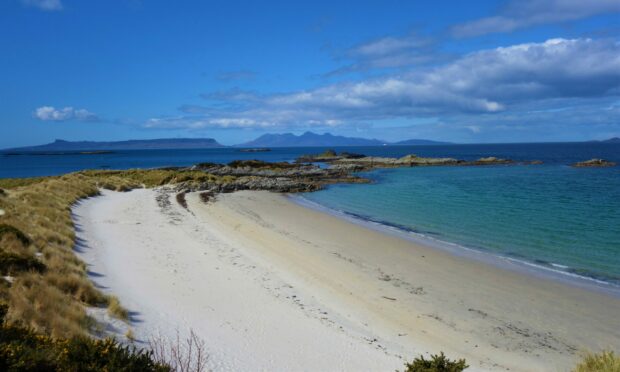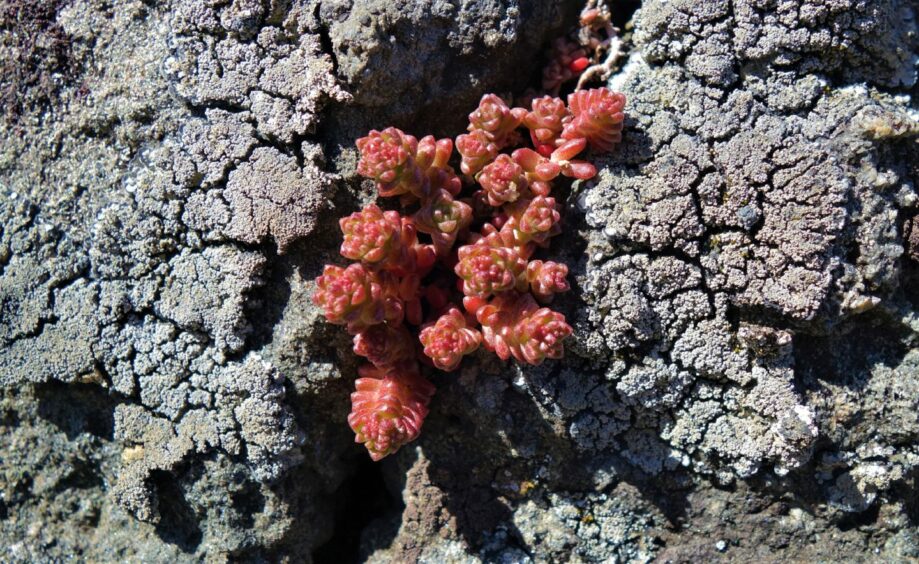The sweet aroma of coconut wafted through the air – the delicious scent of the bright yellow flowers of gorse that gleamed and smouldered in the spring sunshine by the sand-dunes at Camusdarach Beach, which lies between Arisaig and Mallaig.
Gorse flowers are dazzling, and it is said the pioneering eighteenth-century Swedish botanist, Carl Linnaeus, fell on his knees and wept the first time he encountered gorse in its full blooming glory.
Although not universally loved, gorse is important to our environment, not least in providing useful nesting sites for linnets and stonechats. In winter, their flowers attract early pollinating insects.
On one bare, dead gorse branch I discovered the encrusting, jellified mass of yellow brain fungus, its intricate folds and tucks resembling the structure of an animal’s brain.
Spectacular beaches
Camusdarach is one of Scotland’s most spectacular beaches, a white sandy sweep with crystal clear, turquoise water.
Beyond the main beach further south, there are several sandy bays, each one a treasure trove of life.
Out at sea, the horizon is dominated by the long flat plateau of the island of Eigg, with the prominent top of An Sgùrr breaking the skyline like a shark’s fin.
The mountains of Rum also loom large, as do the dark, serrated peaks of the Cuillin mountains of Skye.
Some plants are incredibly hardy, and no more so than the little, crimson-tinged stonecrops that were secreted in cracks in the rocks close to the tideline.
They are interesting plants, the succulent waxy leaves designed to maximise water retention in this harsh, wind-blown, and salt-laden environment.
Black-throated diver
The previous day, on a visit to Loch Shiel, I glimpsed a black-throated diver out on the water.
They are handsome birds, with their grey heads, and sharply defined black throats bordered with wavy, dark, finely scribbled streaks.
An endearing Scottish name for the black-throated diver is the northern doucker, a reference to its diving habits.
Loch Shiel is a long sliver of freshwater that stretches for 28 km from Acharacle in the south west to the famous Glenfinnan Monument in the north-east, erected in 1815 in tribute to the Jacobite clansmen who fought and died in the cause of Bonnie Prince Charlie during the 1745 Rising.
This was a place bustling with life, including willow warblers eagerly delivering their sweet cascading songs and a pair of male blackcaps bickering among the branches of a straggly birch.
A small pebbly beach was too tempting to resist, so I hunkered on a waterside boulder to have lunch, where the distant melancholy wails of the black-throated diver broke the air.
In local folklore, if black-throated divers lose their young, a mournful song can be heard on the loch.
It was too early in the season for egg laying to have even begun, so this was certainly no lament, and instead was probably the call of a male seeking a mate.
The diver’s cry had a wondrous uplifting quality, almost as if all of nature was singing out from the silver-flecked ripples of the loch.

